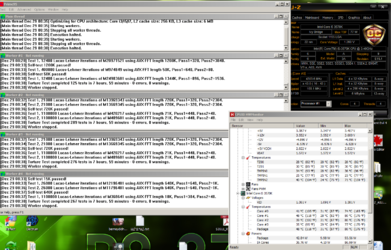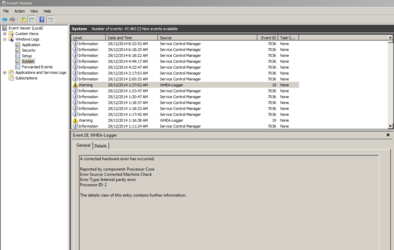- Joined
- Sep 7, 2013
For those who find this thread, up your Vcore a bit. If you still get WHEA errors (even one!) back off your overclock and try again until you get ZERO WHEA errors. Either you have a crappy chip, or a crappy motherboard with weak power delivery systems like me.
---------------------
I'm lost and confused.
It started when Borderlands would randomly quit without warning, then HWmonitor would quit without warning..
Then I saw boatloads of WHEA errors in Event Viewer!
I need help getting rid of these before I can move on to getting X-Fire to play nice.
Specs:
i5 3570K 43x100 @ 1.26Vcore
G.Skill Ripjawsx 9-9-9-24 @1600
Windows 7 Ultimate x64
MSI R7850 @ 1120 core 1250 memory 1.15Vcore
Sapphire 270x @ 1120 core 1500 memory 1.245Vcore
Gigabyte Z77-HD4
LLC set to Extreme
Coolermaster i600 80+ Bronze PSU
What I have tried to troubleshoot:
Set OC lower (4.0 Ghz, 1.32 Vcore) -> No WHEA errors
Set stock clocks (1.32 Vcore) -> No WHEA errors
Set stock clocks, keeping RAM OC (9-10-9-28 1T @1866, 1.66 Volts) -> No WHEA errors
Set OC higher (4.4Ghz 1.32 Vcore) -> Lots of WHEA errors
Set RAM to XMP (4.4 Ghz 1.36 Vcore, 1.66 RAM voltage) -> Still get WHEA errors
Set OC high + high Vcore (4.5Ghz, 1.4 Vcore) -> Lots of WHEA errors
Some screenshots:
3 things I think can be the issue:
I set some setting wrong
CPU simply can't handle speeds over 4.2 Ghz
Motherboard's VRM (4+1+1) simple can't provide enough/clean power
Any idea's?
---------------------
I'm lost and confused.
It started when Borderlands would randomly quit without warning, then HWmonitor would quit without warning..
Then I saw boatloads of WHEA errors in Event Viewer!
I need help getting rid of these before I can move on to getting X-Fire to play nice.
Specs:
i5 3570K 43x100 @ 1.26Vcore
G.Skill Ripjawsx 9-9-9-24 @1600
Windows 7 Ultimate x64
MSI R7850 @ 1120 core 1250 memory 1.15Vcore
Sapphire 270x @ 1120 core 1500 memory 1.245Vcore
Gigabyte Z77-HD4
LLC set to Extreme
Coolermaster i600 80+ Bronze PSU
What I have tried to troubleshoot:
Set OC lower (4.0 Ghz, 1.32 Vcore) -> No WHEA errors
Set stock clocks (1.32 Vcore) -> No WHEA errors
Set stock clocks, keeping RAM OC (9-10-9-28 1T @1866, 1.66 Volts) -> No WHEA errors
Set OC higher (4.4Ghz 1.32 Vcore) -> Lots of WHEA errors
Set RAM to XMP (4.4 Ghz 1.36 Vcore, 1.66 RAM voltage) -> Still get WHEA errors
Set OC high + high Vcore (4.5Ghz, 1.4 Vcore) -> Lots of WHEA errors
Some screenshots:
3 things I think can be the issue:
I set some setting wrong
CPU simply can't handle speeds over 4.2 Ghz
Motherboard's VRM (4+1+1) simple can't provide enough/clean power
Any idea's?
Last edited:




